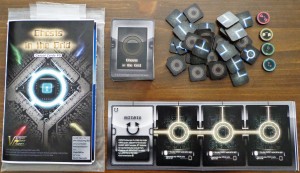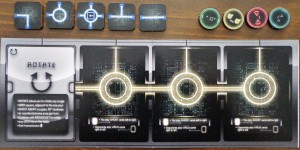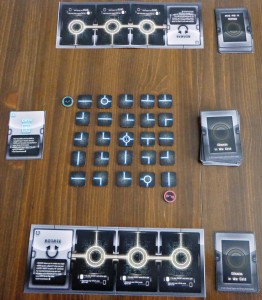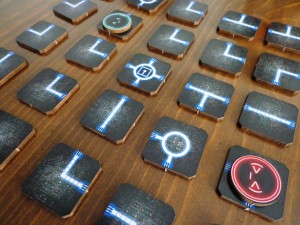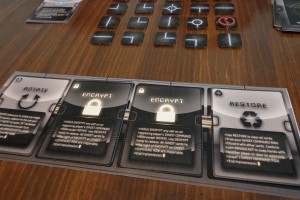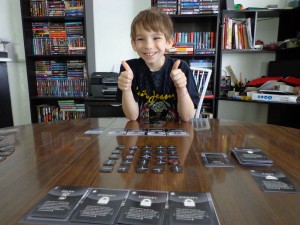Information technology has made leaps and bounds over the last twenty years. I remember as a kid playing “text adventures” on my dad’s TRS-DOS system, which was all black and white output at the time. In grade school, I can’t count how many times “Sara” died of dysentery. In high school, I remember grinding my teeth in frustration as AOL attempted to connect to the Internet for its eighth time while it made god-awful sounds that could only be described as Johnny Five being dragged through an oversized meat grinder. Today, I find that technology has finally caught up and surpassed an aging mind to where I rely on my eleven year old to work the DVR thingy on my television.
Luckily, I don’t have to know a lot about networking and viruses to crash my son’s quote unquote “computer” in “Ghosts in the Grid”. Ghosts in the Grid is a two to four player game that puts agents into the networking realm to steal data and escape before their opponents do. Before we begin “hacking the planet” like Dade from the movie “Hackers”, I’d like to thank Stephanie Marroquin from Victory Point Games for sending me a free copy of Ghosts in the Grid for me to review.
Components
Grid Tiles: The main playing area is made up of tiles, each one depicting a different part of the grid. One of those tiles is the central node, which players must reach to retrieve the data and then escape. The rest of the tiles show varying pipelines that bend and twist different ways, providing players with the path they need to reach the central node.
Command Row: Each player receives a board that has space for four different cards, one of which is imbedded in the board as a permanent ability. Players will be playing cards on their command row to allow them to perform special actions and manipulate the grid.
Cards: The deck is made up of “Ghost” cards which assist the card’s owner and “Virus” cards which hurt someone else in some way. Ghost cards are played on the owner’s command row and Virus cards are played on the an opponent’s command row.
Agent Markers: There are four, one of each color, which allow players to keep track of their progress on the grid.
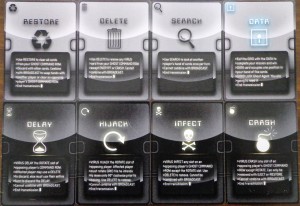
Top: Ghost Cards, Bottom: Virus Cards. The Data card is given to the first player to reach the central node.
Setup
Players begin by finding the central data node (the tile with pipelines extending in all four directions) and placing it in the center of the table. Then, players place grid tiles face up in a 5×5 grid around it randomly. The Data card is placed nearby and the rest of the deck is shuffled. Each player receives a command row and five cards, placing their agent marker near a corner of the grid. The starting player is chosen randomly.
Gameplay
On a player’s turn, they perform the following actions:
1. Play Ghost Cards – The player may play Ghost cards on their command row, left to right.
2. Play Virus Cards – The player may play Virus cards on their opponents’ command rows, right to left. Limit two Virus cards per opponent.
3. Perform Virus Card Actions – The player MUST perform the actions of the Virus cards on their own command row.
4. Perform Ghost Card Actions – The player may perform the actions of the Ghost cards on their command row. Limit one action per card.
5. Move Agent – The player may move their agent to an adjacent part of the grid so as long as the pipelines connect.
6. Discard and Draw – The player may discard one card and draw up to their five-card hand limit. If the agent is on a part of the grid with a node on it (circle), they may discard more than one card.
Players continue taking turns until one of them reaches the central node and escapes with the Data card. If a player’s command row is filled up with Virus cards, they have until the “perform Virus action phase” to get rid of at least one of them. Otherwise, they become assimilated, lose the Data card, and remain outside of the grid until they can remove at least one Virus card from their command row.
The above is simply an overview to give you an idea on how the game is played. To read about the game in more detail, please check out the manual here:
The Review
The components are very easy on the eyes, I especially like the color schemes and how they maintain a futuristic look. The grid tiles fell victim to the same problems as the tiles in Boom & Zoom in that they contained soot that rubbed off on my hands, but it wasn’t as bad. A representative from Victory Point Games mentioned that there was a problem with the equipment at one point which caused the laser to burn a bit too hot, creating an unusual amount of extra soot. They assured me that they were addressing the issue and getting that fixed so as to reduce the amount of soot that would result when producing the components. As a side note, I have to say that I really appreciate Victory Point Games’ customer service and their willingness to address these issues.
The game’s learning curve was fairly light and it didn’t take me long to learn how to play, nor did it take long for me to teach Vinnie (11) how to play. The manual did a pretty good job in explaining the rules, but there were a few things that I was confused about while I was playing that I couldn’t find an answer to. For example, the rules state the Ghost cards are played on the player’s command row and their effects may be carried out after the Virus cards’ actions are. So, what happens if you have two Encrypt cards in the middle of your command row, which blocks other cards from being placed there AND prevents Ghost cards to their right from being used? I couldn’t use the Recycle card on my command row to remove these Decrypt cards since they prevent its use. Are some of these Ghost cards thus played immediately, ignoring the Virus cards’ effects? Could I have placed the Recycle card overtop my embedded Rotate card slot instead? The rules don’t specify. Without some house rules intervening, I would have been crippled for the majority of the game. I really would have liked a clearer understanding of how some of these cards interacted with each other.
The strategy element kept me interested as I was constantly trying to find ways to rotate and move around grid tiles to keep my son from winning. He got an early lead on me by assimilating me on my second turn…he was ruthless with those Virus cards. The Virus cards can be incredibly powerful, so I may try limiting a player to playing one Virus card per opponent per turn as opposed to two, just to see if this gives players more time to react to things happening on their command row. There is a bit of luck involved in drawing the Ghost cards you need to offset some of those nasty Virus cards, so I’ll be interested in trying out different variants to mold the best playing experience for our family.
I appreciate how flexible the game allows you to be when setting up the grid. The tiles allow players to create whatever design they’d like. Combining two games together effectively increases the player limit to eight and the extra number of tiles can effectively increase the size of the grid. Creative individuals will really enjoy coming up with their own playing fields.
Vinnie had a lot of fun with the game and enjoyed combining card effects to really bring the hurt on his dad. He was swapping out tiles to slow me down as well as played Virus cards that forced me to rotate the tile I wanted to move to whether I wanted to rotate it or not. By the time I reached the central node, he was halfway home with the Data card and my only hope was to get him assimilated, but he played an Eject card that pushed me back off the grid and made me discard all of my cards. By the time I recovered, he had won. He seemed to understand the game mechanics well and was quick to develop his own strategies without my help.
Overall, Ghosts in the Grid is a fun, casual game that would do well on family game night. I enjoyed my experience despite being confused a few times by how the cards were played. If you have the time and are looking to expand your collection, I’d say give this game a closer look!
Final Verdict: 6/10
—
You can find more information on Ghosts in the Grid by visiting the Victory Point Games website or on Board Game Geek, located here:

